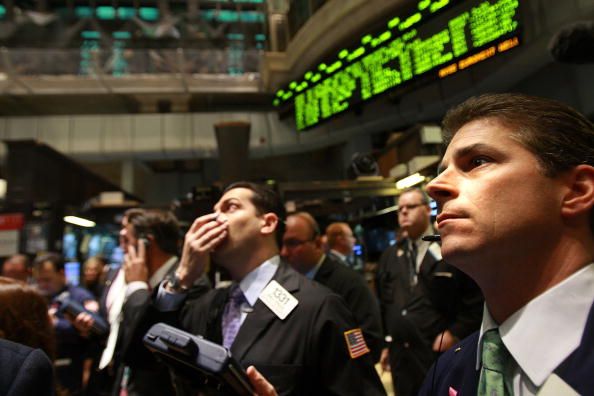Stocks markets had a good run last week on hopes for a Covid-19 treatment and loosening of lockdown restrictions.
At the back end of last week, a report circulated that an antiviral drug – Remdesivir, produced by Gilead Sciences – was showing promising results. It’s believed the drug helped Covid-19 patients with fever and respiratory problems. Even though the treatment is a long way off from being fully tested, the news jolted stocks higher. Gilead Sciences made it very clear that testing is in its early stages, but nonetheless dealers piled into equities.
A number of European countries eased some of their lockdown restrictions. Italy, Spain and Austria saw the re-opening of some businesses. In the grand scheme of things, the level of progress is tiny, but the message it sends out is very positive. Last week, Germany confirmed that they will allow certain businesses to re-open from today. Not all countries are looking to relax the restrictions, as France and the UK have extended their lockdowns into next month, so the picture isn’t positive across the board. Over the weekend, Spain announced plans to extend the lockdown, but restrictions on allowing children outside will be relaxed.
President Trump is eager to get things back to normal in the US, and late last week he mapped out his ‘Opening Up America Again’ plan – a set of guidelines about re-opening the country. The plan is not legally binding, so the decision will ultimately lie with state governors. States are encouraged to enter ‘phase one’ of the programme if there is evidence that new infections are in decline – that would bring about an easing of restrictions. Mr Trump believes that a lot of states are in a ‘very good position’. It is possible that as many as 29 states could see a slight easing of restrictions ‘relatively soon’.
On Friday, the Dow Jones closed above 24,000 for the first time since 10 March. The Dow finished up just shy of 3%, while the S&P 500 and NASDAQ 100 closed up 2.68% and 0.85% respectively. The outperformance of the Dow was thanks to Boeing. The stock surged on the news that operations in Washington State will resume this week. The story feeds into the wider narrative that some businesses are going back to normal.
Overnight, the Chinese central bank lowered lending rates for one year and five year loans in a bid to boost domestic demand. The news failed to lift sentiment in equity markets in mainland China. The Nikkei 225 is in the red too.
In recent weeks we have seen some shocking economic reports and last week was no different. The Chinese economy shrank by 6.8% in the first quarter, which undershot the -6.5% forecast that economists had predicted. Keep in mind the Chinese economy grew by 6% in the last quarter of 2019.The latest US jobless claims report came in at 5.24 million. The reading was brutal, but it was an improvement on the 6.61 million registered in the previous week. The updates highlight the damage the coronavirus crisis is having on the world’s two largest economies. US banks are factoring in more pain on the horizon as in excess of $25 billion was set aside for bad loan provisions by the six biggest names in the industry.
The dreadful economic indicators released last week feed into the narrative that demand for oil will fall sharply. OPEC believe that demand for its oil will tumble by 31% - on an annual basis, in the second quarter to 19.73 million barrels per day (bpd) – which would be a thirty-year low. According to Bloomberg, even if OPEC+ managed to fully implement their co-ordinated production cut, that would bring output down to approximately 23.4 million bpd, which would still indicate an oversupply as demand is tipped to be sub 20 million bpd. OPEC+ might fail to achieve their production target so some nations might not fully adhere to the planned reduction in output. WTI fell to a new 18-year low on Friday.
The Baker Hughes report showed a significant drop-off in the number of active rigs in the US. The count slumped from 504 to 438 – its lowest since late 2016.
The selling pressure on WTI continued overnight as concerns about demand and storage capacity in the US weighed on sentiment. WTI dropped to a level last seen in 1999. It has rebounded off the lows of the session.
US lawmakers are hammering out the terms of a new small business loan fund. The move comes as the Paycheque Protection Programme ran out of funding last week – which was almost $350 billion. There is talk that new funds of $370 billion would be made available.
Gold ended last week on a negative note as the optimism surrounding the loosening of restrictions and the Covid-19 treatment encouraged traders to embrace a higher risk strategy. The metal suffered as dealers funnelled cash into stocks, and therefore gold’s demand fell. The asset closed below the $1,700 mark for the first time in over one week.
At 7am (UK time) German PPI for March will be posted and the consensus estimate is -0.8%, which would be a big decline from the -0.1% posted in February. A poor reading is likely to be interpreted as a sign of falling demand.
At 1.30pm (UK time) the Chicago Fed National Activity Index will be revealed. Dealers are expecting -4, and keep in mind the February reading was 0.16.
EUR/USD – while it holds below the 100-day moving average at 1.1026, the currency pair could lose further ground. Support might be found at 1.0768, and a break below it might pave the way for 1.0636 to be tested. A move through 1.1026 might put 1.1147 on the radar.
GBP/USD – has been in an uptrend since late March and resistance might come into play at 1.2650 – 200-day moving average. Beyond that metric, the 1.2800 region might act as resistance too. A move lower from here might see it target 1.2360.
EUR/GBP – has been pushing lower since mid-March and should the bearish trend continue it might target 0.8613 – the 100-day moving average. A rebound might target 0.8865 or 0.9000.
USD/JPY – is in a negative trend and further losses from here might see it target 106.91. A move through 106.91 might put 106.00 on the horizon. A move above 109.38 could see it target 110.00.
Disclaimer: CMC Markets Singapore may provide or make available research analysis or reports prepared or issued by entities within the CMC Markets group of companies, located and regulated under the laws in a foreign jurisdictions, in accordance with regulation 32C of the Financial Advisers Regulations. Where such information is issued or promulgated to a person who is not an accredited investor, expert investor or institutional investor, CMC Markets Singapore accepts legal responsibility for the contents of the analysis or report, to the extent required by law. Recipients of such information who are resident in Singapore may contact CMC Markets Singapore on 1800 559 6000 for any matters arising from or in connection with the information.








